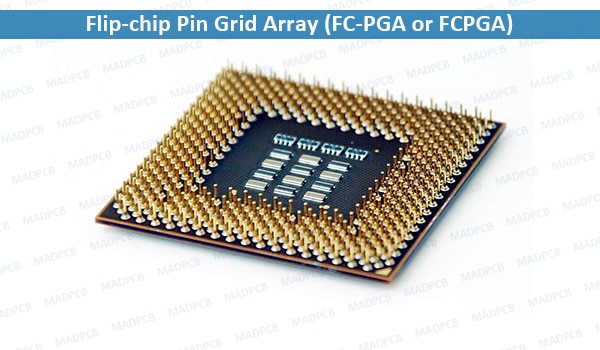What’s FCPGA Package?
A Flip-chip Pin Grid Array (FC-PGA or FCPGA) is a form of pin grid array (PGA) in which the die faces downwards on the top of the substrate with the back of the die exposed. This allows the die to have a more direct contact with the heatsink or other cooling mechanism.
The FC-PGA was introduced by Intel with the Coppermine core Pentium III and Celeron processors based on Socket 370, and was later used for Socket 478-based Pentium and Celeron processors. FC-PGA processors fit into zero insertion force (ZIF) Socket 370 and Socket 478-based motherboard sockets; similar packages have also been used by AMD. It is still used today for mobile Intel processors.
According to Intel, the FC-PGA chip design is better than previous designs for several reasons:
- It protects the delicate circuitry of its microprocessor by making it easier to insert and remove the microprocessor within a computer. This is accomplished by way of its pin grid array construction, described below.
- It allows the microprocessor to operate more easily at its optimal temperatures by designing the processor core on the “flip side” (or backside) of the chip, facing away from the motherboard. (The processor core, or silicon core, contains the delicate microprocessor engine that controls all of its actions.)
- Due to its flip-chip design, an FC-PGA microprocessor requires fewer hardware components (such as a thermal plate or heat spreader) than other chips in order to dissipate heat from the core and maintain its optimal temperature. In place of these components, an FC-PGA microprocessor allows a heatsink or other thermal device to be attached directly to the back of the processor, where the core resides.
In general, PGA (pin grid array) chip packages (or PGA form factors, as they are also called), have 370 PINs “arrayed” in a series of square “grids” at the bottom of the microprocessor. This square-pin design allows a computer hardware technician to smoothly plug the microprocessor into a PGA370 socket on a computer’s motherboard, using little-to-no force. PGA370 sockets are designed with a Zero Insertion Force (ZIF) feature that helps the PGA chip to slide easily in and out of its socket.
Currently, two types of PGA chip packages exist for Intel Celeron and Pentium III processors: PPGA (plastic pin grid array) and FC-PGA (flip chip-pin grid array). PPGA chip packages are designed with the processor core facing down toward the motherboard, whereas FC-PGA packages have the processor core flipped up on the back of the chip, facing away from the motherboard. Each PGA package requires different thermal designs and components in order to keep the chips cool.
Incidentally, in order to use either type of PGA microprocessor with its associated PGA370 socket, a computer’s motherboard must support certain guidelines, known as VRM specifications. (For PPGA processors, the motherboard must support VRM 8.2 specifications. For FC-PGA processors, the motherboard must support VRM 8.4 specifications.)

